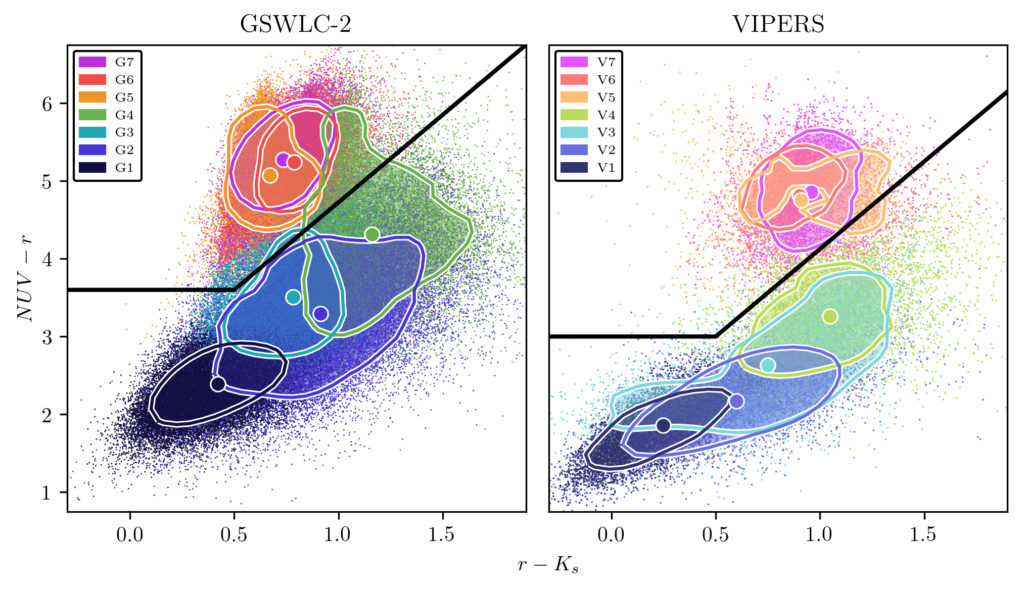Attenuation proxy hidden in surface brightness – colour diagrams. A new strategy for the LSST era.
K. Malek, Junais, A. Pollo, M. Boquien, V. Buat, S. Salim, S. Brough, R. Demarco, A. W. Graham, M. Hamed, J. R. Mullaney, M. Romano, C. Sifon, M. Aravena, J. A. Benavides, I. Busa, D. Donevski, O. Dorey, H. M. Hernandez-Toledo, A. Nanni, W. J. Pearson, F. Pistis, R. Ragusa, G. Riccio, J. Roman
Astronomy & Astrophysics 2024 (in press)
Large future sky surveys, such as the LSST, will provide optical photometry for billions of objects. This paper aims to construct a proxy for the far ultraviolet attenuation (AFUVp) from the optical data alone, enabling the rapid estimation of the star formation rate (SFR) for galaxies that lack UV or IR data. Based on the SDSS galaxy sample, we have found that the dust attenuation is best correlated with (u-r) colour and the surface brightness in the u band (μu). We provide a dust attenuation proxy for galaxies on the star-forming main sequence, which can be used for the LSST or any other type of broadband optical survey.
Forthcoming deep optical observations of the LSST Deep Drilling Fields, which also have multi-wavelength data, will enable one to calibrate the obtained relation for higher redshift galaxies and, possibly, extend the study towards other types of galaxies, such as early-type galaxies off the main sequence.
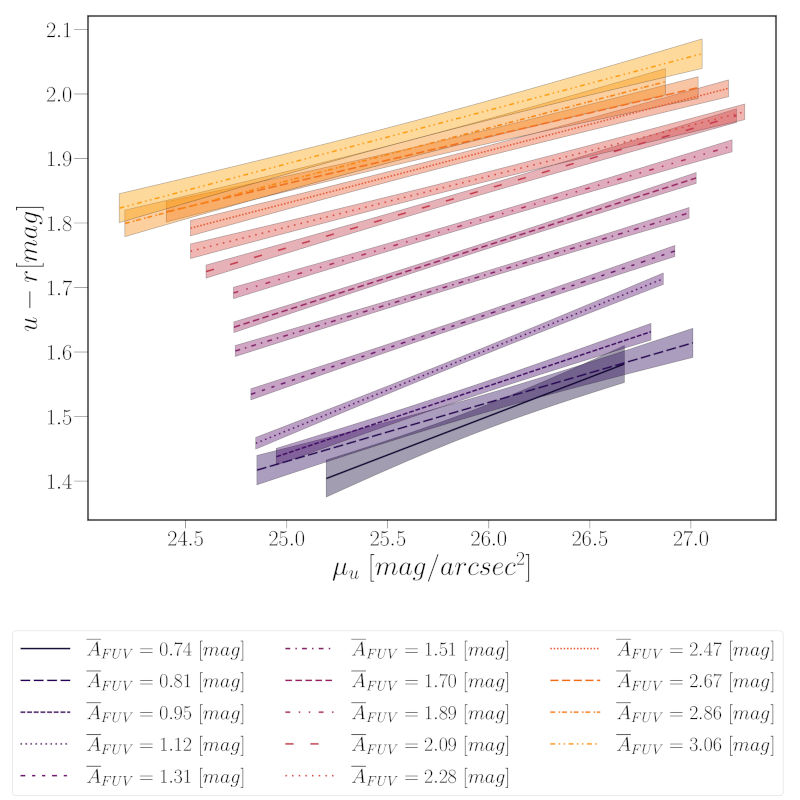
Environments of red nuggets at z 0.7 from the VIPERS survey
M. Siudek, K. Lisiecki, J. Krywult, D. Donevski, C.P. Haines, A. Karska, K. Małek, T. Moutard,
A. Pollo
Monthly Notices of the Royal Astronomical Society, Volume 523, Issue 3, pp.4294-4308 (2023)
We verified the enviromental properties of red nuggets at intermediate redshift for the first time. Analysis of stellar ages suggests that relics are preferably found in high-density regions
while quiescent red nuggets are overabundant in low-density environments. We speculate that red nuggets have survived to lower redshifts via two channels: i) in low-density environments, where the fraction of red nuggets decreases as time passes due to (very) limited merger activity, ii) in high-density environments, where the number of red nuggets drops at higher redshift due to merger activity and is preserved at lower redshift as the high velocities of clusters prevent them from being cannibalized. Even more, the fraction of red nuggets in clusters may increase due to the addition of red massive normal-size galaxies deprived of their envelopes with cosmic time.
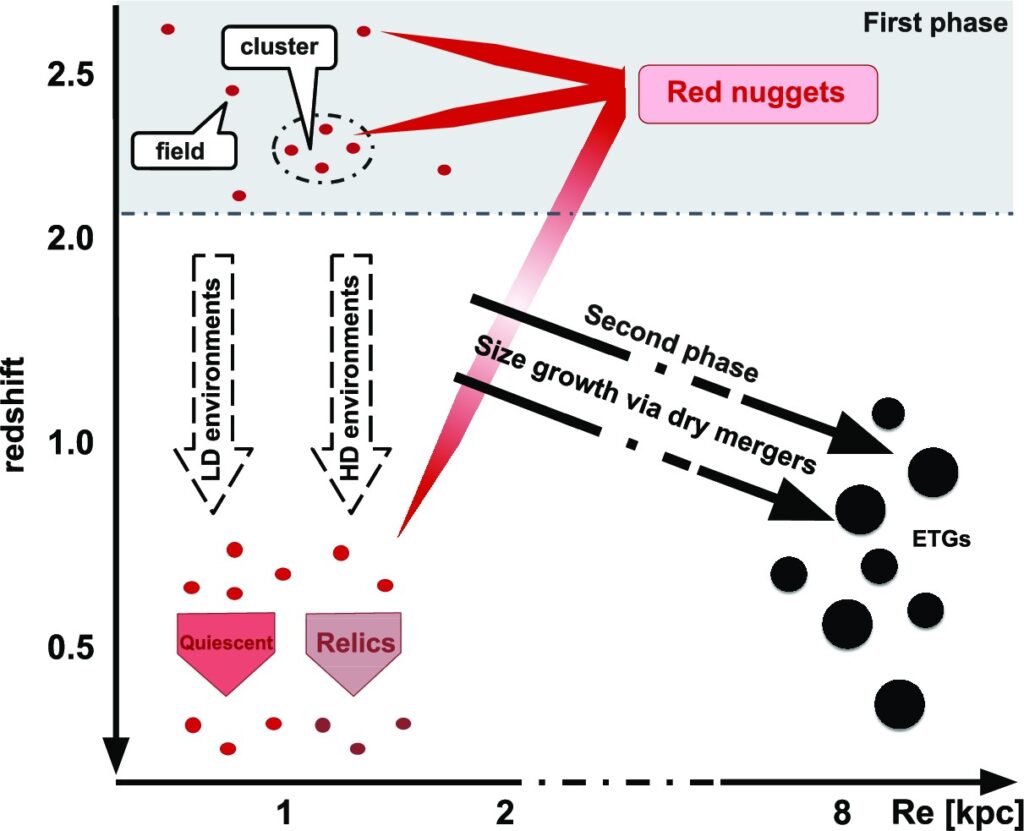
Decoding dust attenuation in star-forming galaxies at intermediate redshift
M. Hamed, F. Pistis, M. Figueira, K. Małek, A. Nanni, A. Pollo, D. Vergani, M. Bolzonella, J. Krywult, Junais, V. Buat, T. Takeuchi, G. Riccio.
Astronomy & Astrophysics, Volume 679, id.A26, 14 pp. (2023)
We found that dust attenuation in star-forming galaxies depends on gas-phase metallicity at intermediate redshift. We analyzed the effect of morphology on dust attenuation, we found that compact objects are more attenuated.
However, we found that environment of galaxies does not play a role in shaping the attenuation of stellar emission. But subtle change in attenuation was observed between edge-on and face-on galaxies.
The complete study is in the PhD thesis of Mahmoud Hamed.
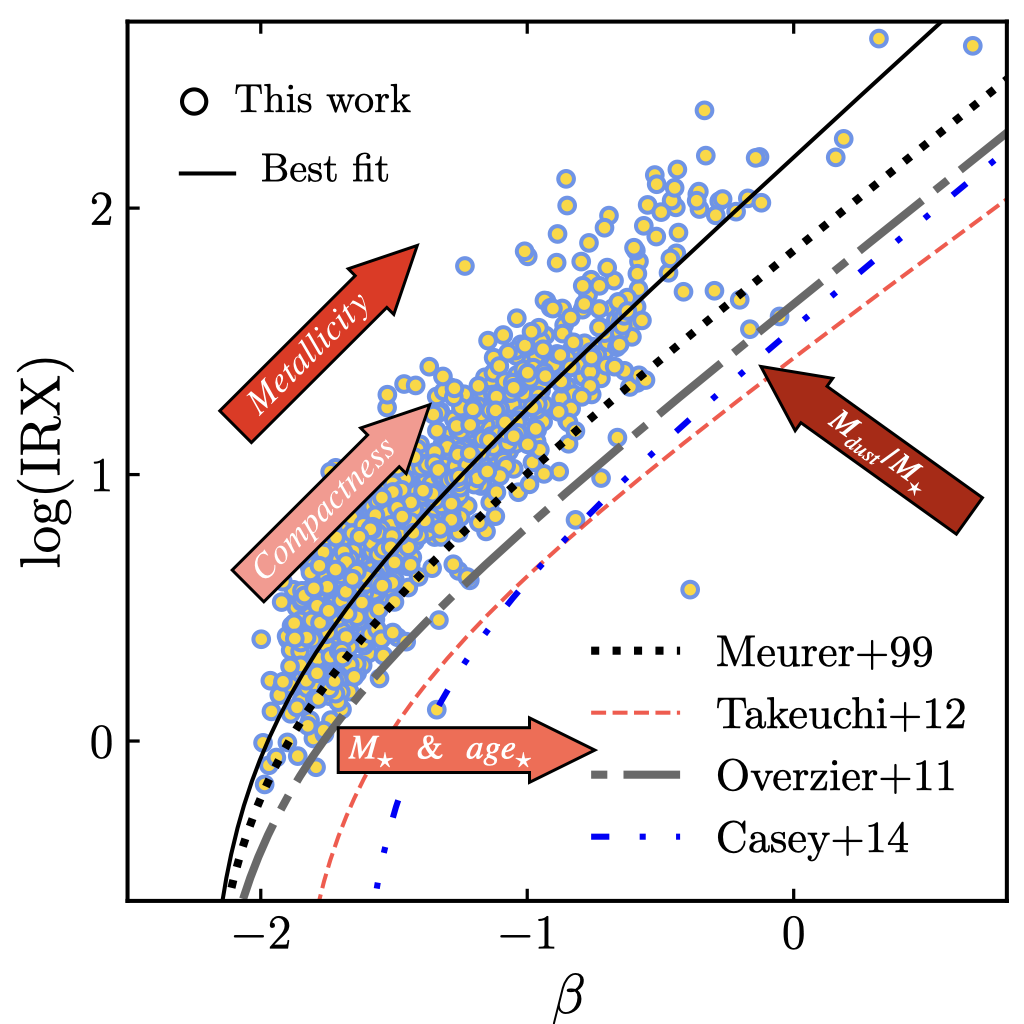
Correlation of dust attenuation laws with morphological extension of dusty star-forming galaxies
M. Hamed, K. Małek, V. Buat, Junais, L. Ciesla, D. Donevski, G. Riccio, M. Figueira
Astronomy & Astrophysics, Volume 674, A99 (2023)
We investigated dust attenuation laws in the largest sample of IR-detected galaxies studied from the aspect of dust attenuation. We find that the physical parameters calculated from our models strongly depend on the assumption of dust attenuation curve. As expected, the most impacted parameter is the stellar mass, which leads to a change in the “starburstiness” of the objects. We find that taking into account the relative compactness of star-to-dust emission prior to SED fitting is crucial, especially when studying dust attenuation of dusty star-forming galaxies. Shallower attenuation curves did not show a clear preference of compactness with attenuation, while the Calzetti attenuation curve preferred comparable spatial extent of unattenuated stellar light and dust emission.

Variation of optical and infrared properties of galaxies with their surface brightness
Junais, K. Małek, S. Boissier, W. J. Pearson, A. Pollo, A. Boselli, M. Boquien, D. Donevski, T. Goto, M.
Hamed, S. J. Kim, J. Koda, H. Matsuhara, G. Riccio, M. Romano
Astronomy & Astrophysics (accepted 2023)
This study analyzes a large sample of low surface brightness galaxies (LSBs) and high surface brightness galaxies (HSBs) to study the variation of their stellar and dust properties. The sample consists of 1631 galaxies selected at z < 0.1 from the North Ecliptic Pole with deep observational data ranging from UV to FIR. The specific star formation rate and specific infrared luminosity remain mostly flat as a function of surface brightness for both LSBs and HSBs that are star-forming but decline steeply for quiescent galaxies. Most LSBs in the sample have negligible dust attenuation, except for 4% of them show significant attenuation and have a high mass-to-light ratio, making them outliers from the linear relation of surface brightness and stellar mass surface density. The study suggests that the dust content of LSBs is more varied than previously thought and that some of them have significant attenuation, which will affect their observations from current/upcoming surveys from JWST/LSST.
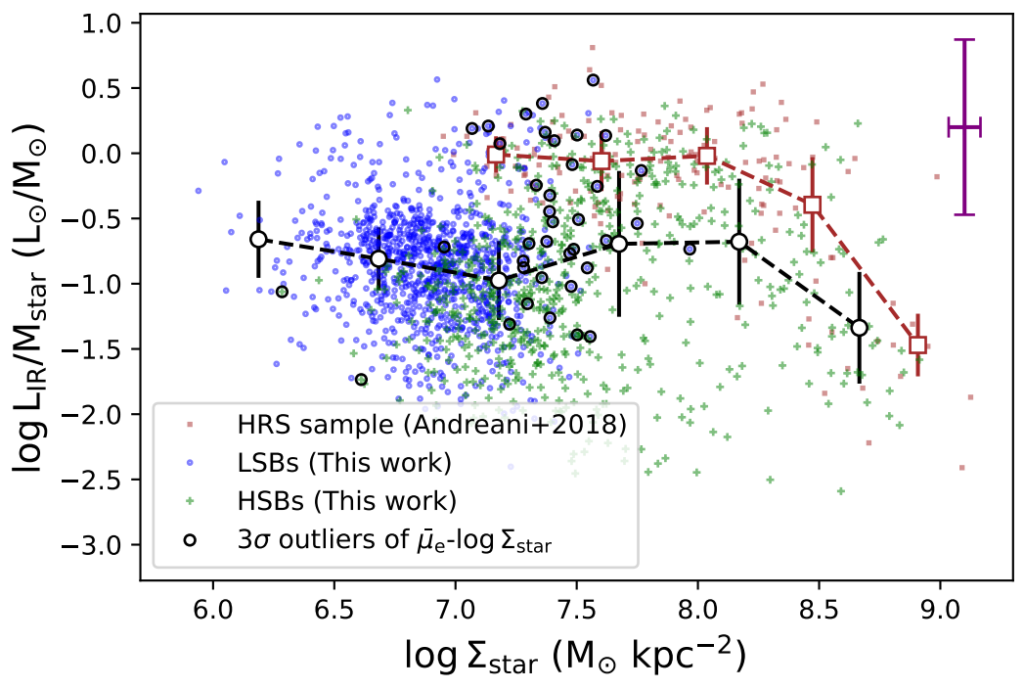
The role of ram-pressure stripping in transforming the diffuse and ultra-diffuse galaxies in the Virgo cluster
Junais, S. Boissier, A. Boselli, L. Ferrarese, P. Côté, S. Gwyn, J. Roediger, S. Lim, E. W. Peng, J. C. Cuillandre, A. Longobardi, M. Fossati, G. Hensler, J. Koda, J. Bautista, M. Boquien, K. Małek, P. Amram, Y. Roehlly
Astronomy & Astrophysics, Volume 667, A76 (2022)
We investigated the formation history of 64 diffuse galaxies and ultra-diffuse galaxies (UDGs) in the Virgo cluster using multiwavelength data from NGVS, VESTIGE, and GUViCS surveys. Our analysis of photometric colors and surface-brightness profiles revealed a color variation with the cluster-centric distance, with blue, H I-bearing galaxies found at larger distances. We compared our findings to models of galaxy evolution and found evidence that most of the galaxies in the sample underwent a strong ram-pressure stripping (RPS) event in their lifetime, transforming initially gas-rich diffuse blue galaxies into gas-poor and red ones. Our study suggests that RPS in dense environments could be a significant mechanism for the formation of the large number of quiescent UDGs observed in galaxy clusters, with the more extreme UDGs having undergone the process in a more distant past on average. These results provide important insights into the formation and evolution of these enigmatic galaxies.
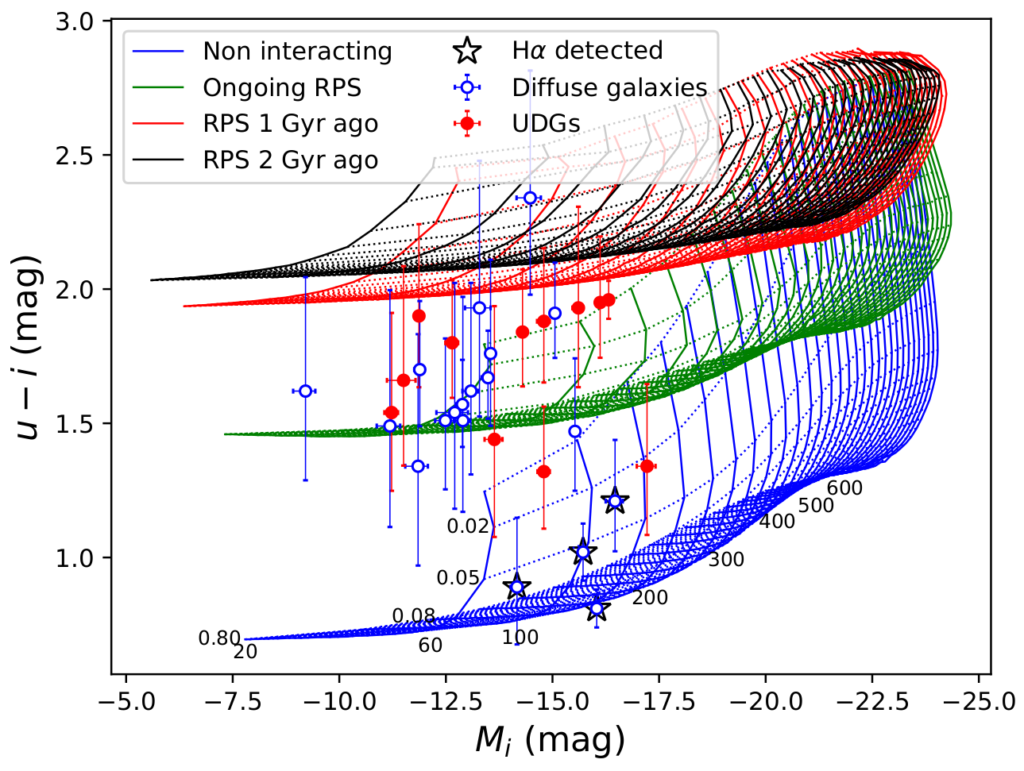
The Art of Measuring Physical Parameters in Galaxies: A Critical Assessment of Spectral Energy Distribution Fitting Techniques
Pacifici, Camilla; Iyer, Kartheik G.; Mobasher, Bahram; da Cunha, Elisabete; Acquaviva, Viviana; Burgarella, Denis; Calistro Rivera, Gabriela; Carnall, Adam C.; Chang, Yu-Yen; Chartab, Nima; Cooke, Kevin C.; Fairhurst, Ciaran; Kartaltepe, Jeyhan; Leja, Joel; Małek, Katarzyna; Salmon, Brett; Torelli, Marianna; Vidal-García, Alba; Boquien, Médéric; Brammer, Gabriel G.; Brown, Michael J. I.; Capak, Peter L.; Chevallard, Jacopo; Circosta, Chiara; Croton, Darren; Davidzon, Iary; Dickinson, Mark; Duncan, Kenneth J.; Faber, Sandra M.; Ferguson, Harry C.; Fontana, Adriano; Guo, Yicheng; Haeussler, Boris; Hemmati, Shoubaneh; Jafariyazani, Marziye; Kassin, Susan A.; Larson, Rebecca L.; Lee, Bomee; Mantha, Kameswara Bharadwaj; Marchi, Francesca; Nayyeri, Hooshang; Newman, Jeffrey A.; Pandya, Viraj; Pforr, Janine; Reddy, Naveen; Sanders, Ryan; Shah, Ekta; Shahidi, Abtin; Stevans, Matthew L.; Triani, Dian Puspita
The Astrophysics Jurnal, 2023, 944:141 , 2023
We present a comprehensive analysis of different SED-fitting codes, including their methods and output, with the aim of measuring the uncertainties caused by the modelling assumptions. We apply 14 of the most commonly used SED-fitting codes on samples from the CANDELS photometric catalogues at z ~ 1 and z ~ 3. We find agreement on the stellar mass, while we observe some discrepancies in the star formation rate (SFR) and dust-attenuation results. To explore the differences and biases among the codes, we explore the impact of the various modelling assumptions set in the codes on the derived stellar masses, SFRs, and A V values. We then assess the difference among the codes on the SFR-stellar mass relation, and we measure the contribution to the uncertainties by the modelling choices in stellar mass (~0.1 dex), SFR (~0.3 dex), and dust attenuation (~0.3 mag). Finally, we present some resources summarizing best practices in SED fitting.
The first catalogue of spectroscopically confirmed red nuggets at z ∼ 0.7 from the VIPERS survey. Linking high-z red nuggets and local relics
Lisiecki, Krzysztof ; Małek, Katarzyna ; Siudek, Małgorzata ; Pollo, Agnieszka ; Krywult, Janusz ; Karska, Agata ; Junais
Astronomy & Astrophysics, Volume 669, id.A95, 16 pp., 2023
Red nuggets are a rare population of passive compact massive galaxies thought to be the first massive galaxies that formed in the Universe. First found at z ∼ 3, they are even less abundant at lower redshifts, and it is believed that with time they mostly transformed through mergers into today’s giant ellipticals. The red nuggets that managed to escape this fate can serve as unique laboratories to study the early evolution of massive galaxies. In this paper, we aim to make use of the unprecedented statistical power of the VIMOS Public Extragalactic Redshift Survey to build the largest up-to-date catalogue of spectroscopically confirmed red nuggets at the intermediate redshift 0.5 < z < 1.0. The resultant catalogue of 77 spectroscopically confirmed red nuggets is the largest, built based on the uniform selection criteria above the local Universe.

Shaping physical properties of galaxy subtypes in the VIPERS survey: Environment matters
Siudek, M. ; Małek, K. ; Pollo, A. ; Iovino, A. ; Haines, C. P. ; Bolzonella, M. ; Cucciati, O.; Gargiulo, A. ; Granett, B. ; Krywult, J. ; Moutard, T. ; Scodeggio, M.
Astronomy & Astrophysics, Volume 666, id.A131, 15 pp., 2022
This study aims to explore the relation between the physical properties of different galaxy sub-classes, from red passive to blue star-forming, and their environment. Our work is based on the analysis of 31 631 galaxies from the VIMOS Public Extragalactic Redshift Survey (VIPERS), observed at 0.5 < z < 0.9. We confirm that the galaxy population-density relation is already in place at z ∼ 0.9, with the blue galaxy fraction decreasing with density, compensated by an increase in the red fraction. We demonstrate how the properties of red, green, and blue galaxy subclasses are altered as they assemble into denser regions. We attempt to interpret this in the context of their evolution. On average, red galaxies in the high-density environments are larger by 28% than those in low-density environments. Low-mass green (9.5 ≲ log(Mstar/M⊙)≲10.6) galaxies appear to have grown through secular processes, while in high-mass (10.6 ≲ log(Mstar/M⊙)≲11.5) green galaxies, mass assembly appears to be dominated by mergers. When it comes to blue galaxies, the trend of decreasing fraction with denser environments seen for the group is driven mostly by compact low-mass galaxies with high, specific star formation rates, which are preferentially found in low-density environments.

AGN in the ULIRG HE 0435−5304
Hryniewicz, Krzysztof; Bankowicz, Małgorzata ; Małek, Katarzyna ; Herzig, Aleksander ; Pollo, Agnieszka
Astronomy & Astrophysics, Volume 660, id.A90, 19 pp., 2022
HE 0435−5304 from Hamburg European Southern Observatory survey is a quasar that appears in the literature with two conflicting redshift values: ∼1.2 and ∼0.4. It was used in the studies of the intergalactic medium through fitting of the narrow absorption lines in its ultraviolet (UV) spectrum. This source is also known historically as a luminous infrared galaxy. The improved redshift value of HE 0435−5304 is estimated to 0.42788 ± 0.00027 based on the [O II] line – the narrowest line in the spectra – which is mostly consistent with the narrowest components of the other emission lines. The source was found to be a relatively massive and luminous AGN whose host galaxy is actively forming stars. Although its stellar population seems to be heavily obscured, we did not find evidence for significant obscuration of the nucleus. We conclude that the AGN HE 0435−5304 is a rather prominent iron emitter from the extreme type-A population very close to the narrow-line Seyfert 1 group.

Getting ready for the LSST data — estimating the physical properties of z<2.5 main sequence galaxies
Riccio, Gabriele ; Małek, Katarzyna ; Nanni, Ambra ; Boquien, Mederic ; Buat, Veronique ; Burgarella, Denis ; Donevski, Darko; Hamed, Mahmoud ; Hurley, Peter ; Shirley, Raphael ; Pollo, Agnieszka
Astronomy & Astrophysics, Volume 653, id.A107, 18 pp.
In this work, we study how to employ the upcoming Legacy Survey of Space and Time (LSST) data to constrain the physical properties of normal, SF galaxies. We use simulated LSST data and existing real observations to test the estimations of the physical properties of galaxies. We perform a simulation of LSST observations and uncertainties of 50,385 real galaxies at 0<z<2.5. In order to achieve this goal, we used the unique multi-wavelength data from the HELP survey. We obtain a clear overestimation of SFR, Ldust, and Mdust estimated with LSST only, highly correlated with z – is related to an overestimation of the dust attenuation. We find that it is necessary to employ auxiliary rest-frame mid-IR observations, simulated UV observations, or FUV attenuation (AFUV)- Mstar relation, to correct the overestimation.
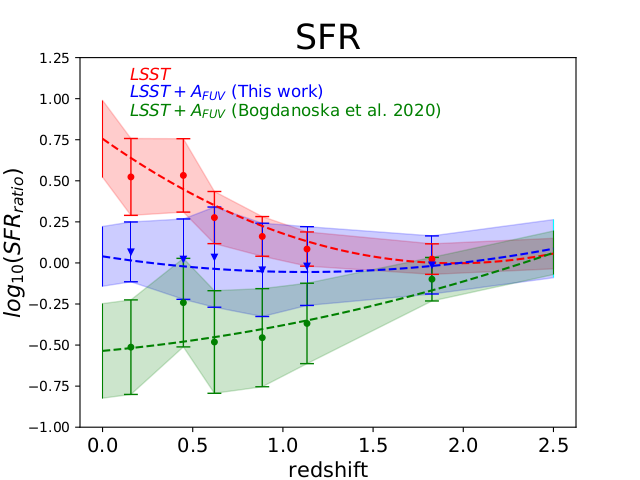
HELP: The Herschel Extragalactic Legacy Project
Shirley, R. ; Duncan, K. ; Campos Varillas, M. C. ; Hurley, P. D. ; Małek, K. ; Roehlly, Y. ; Smith, M. W. L. Aussel, H. ; Bakx, T. ; Buat, V. ; Burgarella, D. ; Christopher, N. ; Duivenvoorden, S. ; Eales, S. ; Efstathiou, A. ; Gonzalez Solares, E. A. ; Griffin, M. ; Jarvis, M. ; Lo Faro, B. ; Marchetti, L. McCheyne, I.; Papadopoulos, A. ; Penner, K. ; Pons, E. ; Prescott, M. ; Rigby, E. ; Rottgering, H. ; Saxena, A.; Scudder, J. ; Vaccari, M. ; Wang, L. ; Oliver, S. J.
Monthly Notices of the Royal Astronomical Society, Volume 507, Issue 1, pp.129-155, 2021
We present the Herschel Extragalactic Legacy Project (HELP). This project collates, curates, homogenises, and creates derived data products for most of the premium multi-wavelength extragalactic data sets. The sky boundaries for the first data release cover 1270 deg2 defined by the Herschel SPIRE extragalactic survey fields; notably the Herschel Multi-tiered Extragalactic Survey (HerMES) and the Herschel Atlas survey (H-ATLAS). Here, we describe the motivation and principal elements in the design of the project.
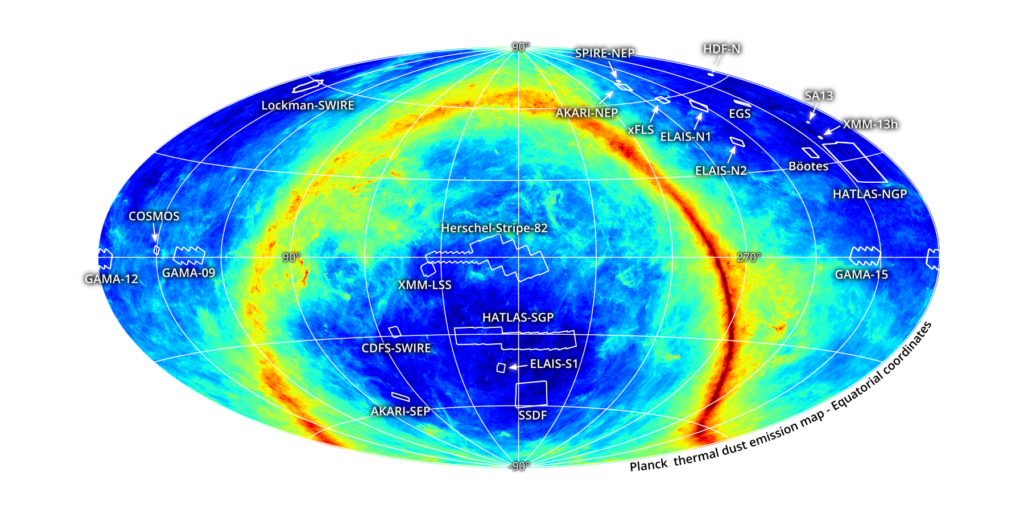
A hyperluminous obscured quasar at a redshift of z~4.3
Andreas Efstathiou, Katarzyna Małek, Denis Burgarella, Peter Hurley, Seb Oliver, Veroqniue Buat, Raphael Shirley, Steven Duivenvoorden, Vicky Papadopoulou Lesta, Duncan Farrah, Kenneth J. Duncan, María del Carmen Campos Varillas
Monthly Notices of the Royal Astronomical Society: Letters, Volume 503, Issue 1, pp.L11-L16, 2021,
Over the past few years, we are part of the project called Herschel Extragalactic Legacy Project or HELP that put together the data from a number of telescopes, including ESA’s Hershel Space Observatory and NASA’s Spitzer Space Telescope, which observed the cosmos at infrared wavelengths. From this data, in the COSMOS field, we have discovered a hidden giant black hole in a galaxy that existed only 1.4 billion years after the Big Bang!
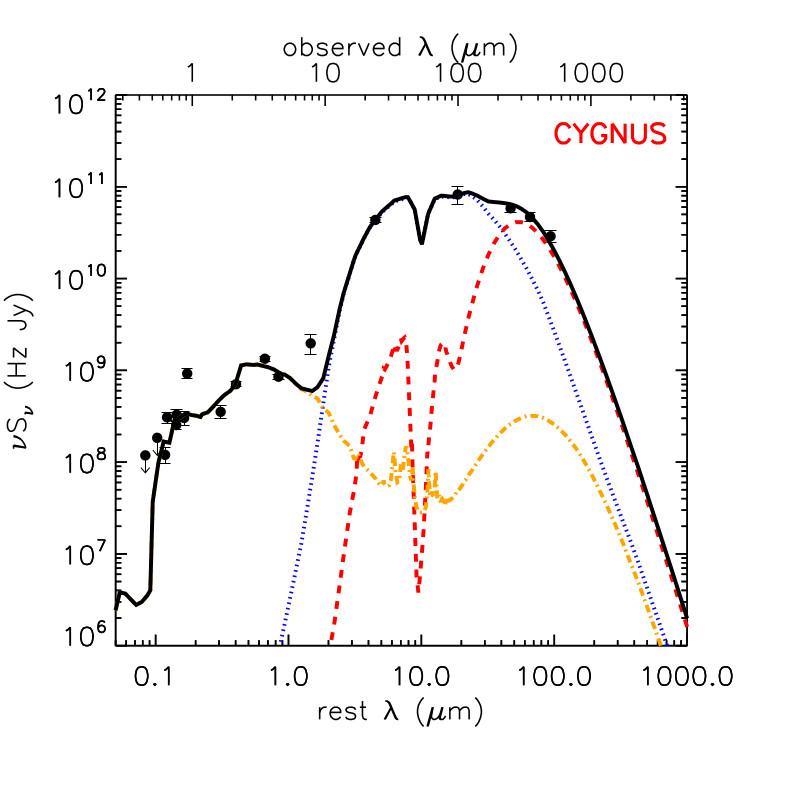
Multiwavelength dissection of a massive heavily dust-obscured galaxy and its blue companion at z∼2
Hamed, M.; Ciesla, L.; Béthermin, M.; Małek, K.; Daddi, E.; Sargent, M. T.; Gobat, R.
Astronomy & Astrophysics, Volume 646, id.A127, 10 pp. 2021
We study a system of two galaxies, Astarte and Adonis, at z ∼ 2. At this time, the Universe was undergoing the peak of its star formation activity. Astarte is a dusty star-forming galaxy at the massive end of the main sequence (MS), and Adonis is a less massive companion galaxy that is bright in the ultraviolet and has an optical spectroscopic redshift. We conclude that that the ultramassive Astarte, which is more massive than our old and mature Milky Way, is dying; Astarte is turning its hydrogen into stars by inertia from its past when it was once a starburst too, like its neighbouring Adonis. This indeed motivates the quest to understand how very massive galaxies form and evolve, and how they deplete their resources while converting them efficiently into stars.
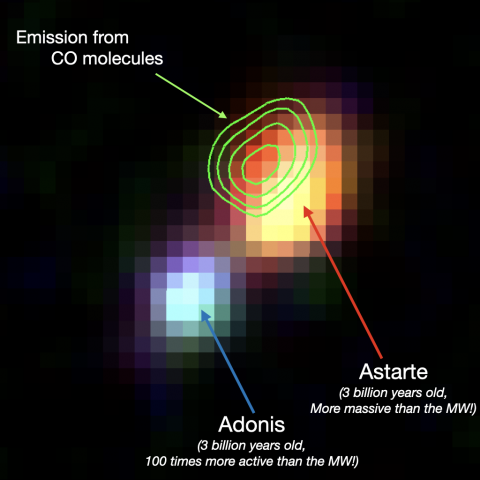
Synergies between low- and intermediate-redshift galaxy populations revealed with unsupervised machine learning
Turner, Sebastian; Siudek, Malgorzata; Salim, Samir; Baldry, Ivan K.; Pollo, Agnieszka; Longmore, Steven N.; Małek, Katarzyna; Collins, Chris A.; Lisboa, Paulo J.; Krywult, Janusz; Moutard, Thibaud; Vergani, Daniela; Fritz, Alexander
Monthly Notices of the Royal Astronomical Society, Volume 503, Issue 2, pp.3010-3031, 2021
The colour bimodality of galaxies provides an empirical basis for theories of galaxy evolution. However, the balance of processes that begets this bimodality has not yet been constrained. A more detailed view of the galaxy population is needed, which we achieve in this paper by using unsupervised machine learning to combine multidimensional data at two different epochs. We aim to understand the cosmic evolution of galaxy subpopulations by uncovering substructures within the colour bimodality. We choose a clustering algorithm that models clusters using only the most discriminative data available, and apply it to two galaxy samples: one from the second edition of the GALEX-SDSS-WISE Legacy Catalogue (GSWLC-2; z ∼ 0.06), and the other from the VIMOS Public Extragalactic Redshift Survey (VIPERS; z ∼ 0.65).
